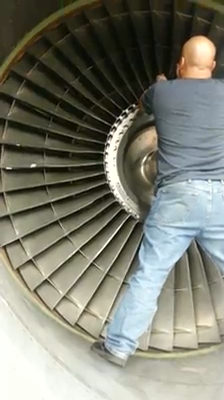Why? I was supposed to be there! But more importantly, I was excited to be there. I was more excited than I've been in a while. The concept of the Future of Making Things is something I not only find appealing, but invigorating.
First of all, the event was held at the California Science Center. Just the location was enough to make me want to start building something!
In the parking lot was a Lockheed A-12. What a way to be greeted!
 |
| The Lockheed A-12. It looks fast just sitting there. |
 |
| I can actually tell you which is a T-38 and which is a F-20 from here. |
Andrew Anagnost kicked things off with his presentation. The information was flowing. But one simple statement made me take a moment of pause.
Five years ago, nobody owned an iPad.
Wow. I had to think about that. iPads are commonplace now, I've used it to store recipes, there are videos of pets playing games on them!
Many of us have seen an iPad replacing a cash register, or seen it used to take notes in lieu of pen and paper. Regulatory agencies like the FAA are placing their regulatory books, many of which are hundreds of pages long, online in a downloadable formats!
 |
| This Advisory Circular from the FAA can now be contained on an iPad, along with a myriad of other books. Image from Marv Golden Pilot Supplies |
And much of that change has come within the last decade!
But there's even more.
Andrew spoke about a 20 story building in China that was assembled on site in fifteen days. How? It wasn't built onsite. The building was modular, with major components assembled offsite, then assembled onsite.
An entire 30 story building, in fifteen days!
Naturally 3D printing was a topic for discussion as well. It's pretty well known that 3D printers are becoming more and more common. Autodesk has their own version called Spark.
But did you also know that the 3D printing of metals is another frontier being developed? A 3D printed heat sink was shown, purely designed and optimized by computer and printed in metal on a 3D printer. By using these methods, they were able to create geometries never before imagined!
 |
| A heat sink designed by computer, and 3D printed in metal. |
The presentation moved on to connected devices. Imagine a world where cars can talk to the infrastructure they're driving on. Imagine traffic signals adjusted to traffic realtime. How? The cars themselves report it.
Andrew used the Skully motorcycle helmet as an another example. Imagine a bluetooth enabled, fully connected motorcycle helmet with a review camera and a heads up display. Ten years ago, this was the realm of the fighter pilot, now it's a device used to make motorcycle riders more connected and safer than before.
It was said "We are living in a connected world". No doubt of that now!
Next, came the CAD demonstrations, Jorge Fernandez and Jeff Brown showed how data from different CAD vendors, obtained through this connected world can be tracked in Autodesk Vault, brought into Inventor, and edited and modified.
They demonstrated how legacy data, the knowledge built of experience,and captured in AutoCAD 2D could be brought into Inventor and reused via DWG Underlay.
Then they tested the data in Nastran In-CAD to validate the design.
Specifically they tested the part in fatigue. After all, it's one thing to be strong enough once, it's another thing to be strong for hundreds of thousands, or even millions of cycles!
All of these tools that used to be exclusive to the specialist are now becoming easier to use and more available. Now they're not limited to the select few of trained individuals, but available to more and more designers, so they can interact with the specialist more effectively.
The data is then returned to Autodesk Vault for safekeeping, and can also be distributed via A360 through connected devices to far flung places in the world for their consumption.
It's a web that's ever expanding, and becoming more powerful than the sum of its individual pieces.
Then after seeing all that awesome technology, the event wrapped up. After saying my goodbyes to some great people, I was lucky enough to visit the Space Shuttle Endeavour, and gain some inspiration from the giants of design who have gone before me.
The future of making things is certainly here, and I think we're all fortunate to be able to be a part of it.
 |
| Endeavour on display. |
 |
| This engine was once part of the Future of Making Things. The Torch has been passed on now. |




















